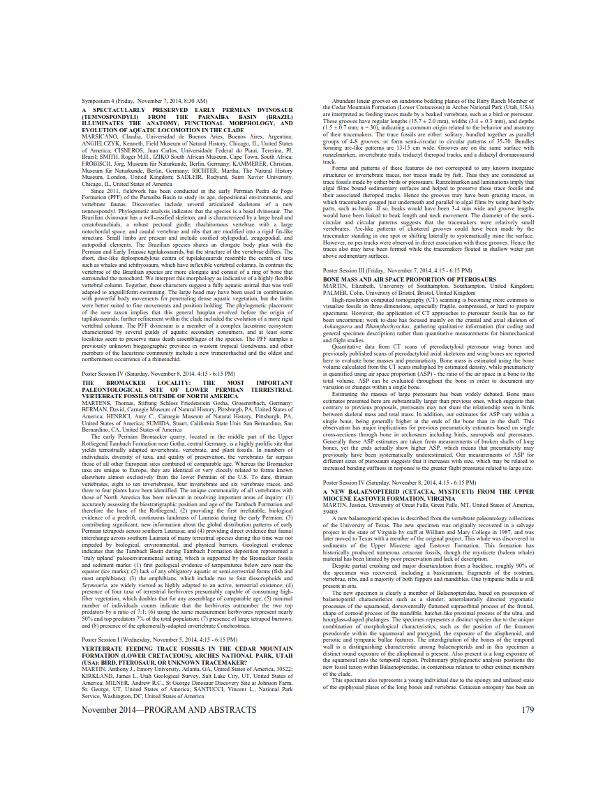Evento
A spectacularly preserved Early Permian dvinosaur (Temnospondyli) from the Parnaíba Basin (Brazil) illuminates the anatomy , functional morphology, and evolution of aquatic locomotion in the clade
Marsicano, Claudia Alicia ; Angielczyk, Kenneth; Cisneros, Juan Carlos; Smith, Roger M. H.; Fröbisch, Jörg; Kammerer, Christian; Richter, Martha; Sadleir, Rudyard
; Angielczyk, Kenneth; Cisneros, Juan Carlos; Smith, Roger M. H.; Fröbisch, Jörg; Kammerer, Christian; Richter, Martha; Sadleir, Rudyard
 ; Angielczyk, Kenneth; Cisneros, Juan Carlos; Smith, Roger M. H.; Fröbisch, Jörg; Kammerer, Christian; Richter, Martha; Sadleir, Rudyard
; Angielczyk, Kenneth; Cisneros, Juan Carlos; Smith, Roger M. H.; Fröbisch, Jörg; Kammerer, Christian; Richter, Martha; Sadleir, Rudyard
Tipo del evento:
Reunión
Nombre del evento:
74th Annual Meeting of the Society of Vertebrate Paleontology
Fecha del evento:
05/11/2014
Institución Organizadora:
Society of Vertebrate Paleontology;
Título de la revista:
Journal of Vertebrate Paleontology
Editorial:
Taylor & Francis
Idioma:
Inglés
Clasificación temática:
Resumen
Since 2011, fieldwork has been conducted in the Early Permian Pedra de Fogo Formation (PFF) of the Parnaíba Basin to study its age, depositional environments, and vertebrate faunas. Discoveries include several articulated skeletons of a new temnospondyl. Phylogenetic analysis indicates that the species is a basal dvinosaur. The Brazilian dvinosaur has a well-ossified skeleton, and is characterized by a large head and ceratobranchials, a robust pectoral girdle, rhachitomous vertebrae with a large notochordal space, and caudal vertebrae and ribs that are modified into a rigid fin-like structure. Small limbs are present, and include ossified stylopodial, zeugopodial, and autopodial elements. The Brazilian species shares an elongate body plan with the Permian and Early Triassic tupilakosaurids, but the structure of the vertebrae differs. The short, disc-like diplospondylous centra of tupilakosaurids resemble the centra of taxa such as whales and ichthyosaurs, which have inflexible vertebral columns. In contrast the vertebrae of the Brazilian species are more elongate and consist of a ring of bone that surrounded the notochord. We interpret this morphology as indicative of a highly flexible vertebral column. Together, these characters suggest a fully aquatic animal that was well adapted to anguilliform swimming. The large head may have been used in combination with powerful body movements for penetrating dense aquatic vegetation, but the limbs were better suited to fine movements and position holding. The phylogenetic placement of the new taxon implies that this general bauplan evolved before the origin of tupilakosaurids; further refinement within the clade included the evolution of a more rigid vertebral column. The PFF dvinosaur is a member of a complex lacustrine ecosystem characterized by several guilds of aquatic secondary consumers, and at least some localities seem to preserve mass death assemblages of the species. The PFF samples a previously unknown biogeographic province in western tropical Gondwana, and other members of the lacustrine community include a new trimerorhachid and the oldest and northernmost occurrence of a rhinesuchid.
Palabras clave:
Permico
,
Gondwana
,
Temnospondily
,
Paleobiology
Archivos asociados
Licencia
Identificadores
Colecciones
Eventos(IDEAN)
Eventos de INSTITUTO DE ESTUDIOS ANDINOS "DON PABLO GROEBER"
Eventos de INSTITUTO DE ESTUDIOS ANDINOS "DON PABLO GROEBER"
Citación
A spectacularly preserved Early Permian dvinosaur (Temnospondyli) from the Parnaíba Basin (Brazil) illuminates the anatomy , functional morphology, and evolution of aquatic locomotion in the clade; 74th Annual Meeting of the Society of Vertebrate Paleontology; Berlin; Alemania; 2014; 179-179
Compartir



